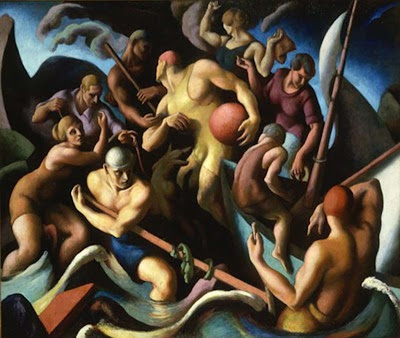Thomas Hart Benton
The great nephew and namesake of the first United States Senator from Missouri, Thomas Hart Benton was on record as disliking homosexuals. Yes, I had to mention that first because it sticks in my “craw,” like a gargantuan dead and broken pine tree straddling a flood engorged gulch. That his dislike stands in opposition to so much of his work about the downtrodden, and/or ordinary working people seems odd. However, Benton’s location in time and place conspired to dispose him to dislike homosexual men. Benton stated his frustration with the usual Art Museum of the time because it was, as he said, “a graveyard run by a pretty boy with delicate wrists and a swing in his gait" with more disparaging vitriol concerning his belief that homosexuals had excessive Art World influence.*1 I can’t deny his belief, nor do I wish to though in the contemporary Art World it is just as likely that a group of trained men and women curators have established themselves as the greatest influence dealing in brobdingnagian artistic enterprises often financed with corporate assistance that require the organizational skills of the likes of a Christo or Nick Cave.
Having gotten that out, let’s deal with Benton’s extraordinary accomplishments. That he was a great art teacher can’t be denied, Jackson Pollock having been one of his protégés. Others among them, Charles Pollock, Jackson’s brother, Lamar Dodd, Frederic James, Charles Banks Wilson and many more. Benton is also placed among the American Regionalist artists like Grant Wood who worked for the most part in the American heartland during the 1930’s and 1940’s. Additionally he was a great muralist. He had spent time in Paris as a student early in the century, and became friendly with Diego Rivera, the Mexican muralist. The similarity in composition, even color between Benton and Rivera’s murals is obvious. Being friends, the influence probably was reciprocated, and worked back and forth over time. Here, the comparison of Benton’s “People of Chilmark” with “Rivera’s “Symbolic Landscape,” demonstrates the way both twist and turn and taper toward the top of the picture plain. Though the Rivera is a gnarled tree trunk, and the Benton is composed of human figures, the two compositions can be superimposed almost element for element. The rower’s ores and the clouds in the upper left portion of Benton’s composition act in similar fashion to the branches of Rivera’s tree. In both artworks, ore and cloud or branches work in opposition to human figures or trunk. The fact of Rivera’s communist affiliation should not prevent the association of the two artist’s works.
People of Chilmark (1920)
Symbolic Landscape (1940)
to be continued
Notes
*1 Wikipedia "Thomas Hart Benton (painter)," http://en.wikipedia.org/wiki/Thomas_Hart_Benton_(painter). Viewed 10:25 AM EST, Sunday, January 16, 2011. Original from "Benton Hates Museums". Time. 1941-04-14. Retrieved 2007-07-29.
*2 The following are copyrighted images. I use them here for one time scholarly purposes.
People of Chilmark (Figure Composition), 1920, oil on canvas, 65 5/8 in. x 77 5/8 in. (166.5 x 197.3 cm.) Wikipedia "Thomas Hart Benton (painter)," http://en.wikipedia.org/wiki/Thomas_Hart_Benton_(painter). Viewed 10:25 AM EST, Sunday, January 16, 2011. Original from the Hirshhorn Museum, Washington DC.
Diego Rivera, Symbolic Landscape, 1940; painting; oil on canvas, 47 7/8 in. x 60 1/8 in. (121.6 cm x 152.72 cm); Collection SFMOMA, Gift of Friends of Diego Rivera; © Banco de Mexico Diego Rivera & Frida Kahlo Museums Trust, Mexico, D.F. / Artists Rights Society (ARS), New York


No comments:
Post a Comment